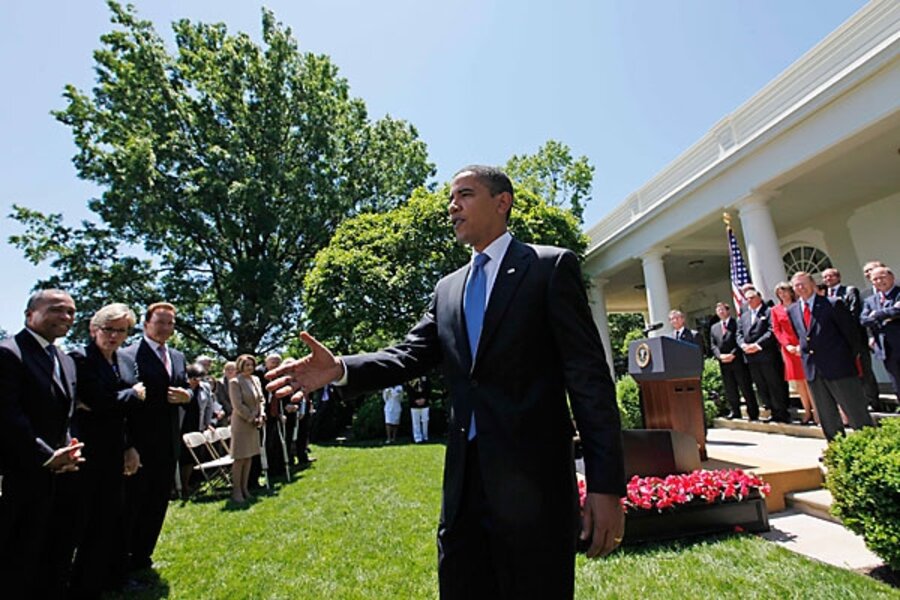New auto standards: the start of Obama's green revolution
Loading...
President Obama’s announcement on tailpipe emissions Tuesday reaffirmed a commitment that goes beyond regulation of the auto industry. The move is part of a broader White House strategy to confront the risk of global warming while making green-collar jobs a centerpiece of the economy.
For ordinary Americans, the resulting changes could be far-reaching. Lighter-weight vehicles appear likely to become more popular. More tax dollars are being tabbed for clean-energy technology. And for years to come, college students might find that some of the hottest job opportunities lie in helping to keep the planet cool.
“The agreement we have announced today is part of a far larger effort,” Mr. Obama said Tuesday as he unveiled plans to tighten carbon emissions from US cars for the first time. As a part of the plan, average fuel economy must reach 35.5 miles per gallon by 2016. He also called for additional “historic investments in a clean-energy economy.”
The strategy is an ambitious one for a nation in recession, a government running record budget deficits, and a president who is also pursuing reform of America’s costly healthcare system.
But Obama contends that the best way out of an economic funk is to look forward to the technologies that might potentially drive the economy in years ahead.
He became salesman-in-chief Tuesday, saying that savings on fuel costs will allow consumers to recoup the costs of the emissions upgrade within three years of a new car purchase.
The potential rewards for the environment and energy security are significant, too. The auto industry accounts for 17 percent of man-made carbon dioxide emissions in the US. Obama said his plan will reduce US oil consumption by an amount equal to a year’s imports from four major oil-supplying nations, including Saudi Arabia.
Still, that forecast also illustrates how far the US has to go if it is going to lead the world toward a reduced-carbon future. The auto policy is just a first step.
Congress is also considering “cap and trade” legislation to limit carbon emissions economy-wide. It would set up a system for trading emission allowances so that the private marketplace can use available fossil fuels most efficiently.
Supporters say that the environmental benefits of cap and trade and automotive-emissions standards far outweigh the cost. Critics such as congressional Republicans say the plan could damage economic growth at a time when the nation is struggling through a recession. While Obama highlights the potential creation of green jobs, critics cite studies forecasting a net loss of jobs due to cap and trade.
One analysis forecasts a bright future for green jobs. The number of jobs tied to renewable energy or energy efficiency could surge in the next two decades to more than four times the 8.5 million jobs supported by those sectors in 2006, according to projections by the American Solar Energy Society. These numbers include indirect jobs such as accountants and truck drivers employed by clean-energy ventures.
John Challenger, an employment expert at the outplacement firm Challenger, Gray & Christmas in Chicago, endorses such projections. The demand could hinge on oil prices as well as federal policies, but green-collar jobs “could present the best career opportunities for a generation of college graduates,” Mr. Challenger says.
Whether or not Obama's plans for a green partnership between the government and private firms work in the long run, he and his team have built early momentum.
He gestured to governors, environmentalists, auto executives, and labor union leaders who flanked him in the White House Rose Garden, saying, “some of the groups here have been embroiled in lawsuits against one another” or have been at odds for decades.
Now, he said, “these leaders from across the country are willing to set aside the past for the sake of the future.”
The diverse group supports the new fuel-economy target for different reasons. For environmentalists, the regulations are a clear victory. But car companies also gain a simpler and more predictable regimen at a time when they are streamlining their product lineups and downsizing. Before the announcement, California and 13 other states had been seeking to establish their own standard. Now, Obama's plan will make that standard a national benchmark.
The scene in the Rose Garden Tuesday echoed Obama’s appearance with healthcare industry officials on May 11, at which he celebrated their commitment to reduce the future pace of price hikes for medical care – for a savings to the nation worth $2 trillion in the next decade, they said.
The public tone of both accords is a collegial affirmation of Obama's “Yes, we can” mantra. In both cases, there is the prospect of large benefits – for the environment or for consumers. Yet in both cases, questions remain about how to actually hit the target.
A group representing automakers, for example, praised Obama’s plan, but said more work is needed to bring it to fruition.
“We have the broad outlines of an agreement, but we will need to work closely with [federal agencies] and California in the rulemaking process to resolve multiple issues,” said Dave McCurdy, president of the Alliance of Automobile Manufacturers, in a statement. “And we are going to need Americans to buy our clean, fuel-efficient autos in large numbers in order to meet this climate change commitment.”





